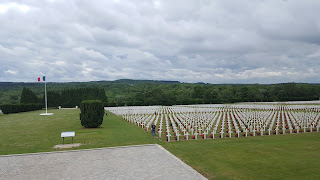Having visited Normandy’s WWII beaches in May, we felt we should also explore a bit of France’s WWI history while staying so close to some of its most famous sites. So, in addition to seeing a few bunkers in the Champagne area on our bike excursion, we took a day trip out to the Verdun battlefields.
The longest-lasting battle of WWI (Feb. 21-Dec. 18, 1916), and one of the costliest battles in military history, Verdun exemplifies the "war of attrition" policy pursued by both France and Germany, leading to more than 700,000 casualties (dead, wounded and missing). There are many monuments and memorials in the area to see and loads of information to digest.
Our first stop was at the memorial to Andre Maginot, the French Minister of War who was responsible for fortifying France in the 1930’s after the damage sustained in WWI’s trench warfare. He was a native of the Verdun area and a veteran of the battle. Of course, in 1940 Germany invaded France through Belgium and Holland, avoiding the Maginot line of defense, and the line is now a metaphor for expensive efforts that offer a false sense of security.
We then visited Fort Douaumont, the largest and highest fort on the ring of 19 large defensive works that had protected the city of Verdun since the 1890s. The fort fell within the first days of the battle of Verdun and wasn’t recaptured until October 1916.
We spent the most time at the Douaumont Ossuary, a memorial containing the skeletal remains of both French and German soldiers who died on the Verdun battlefield. It was built on the initiative of Charles Ginisty, Bishop of Verdun, who took it upon himself to start collecting the soldier’s bones for proper burial. Next to the Ossuary lies the largest WWI French military cemetery with 16,142 graves. It was inaugurated in 1923 by Maginot.
The site includes a memorial to Jewish soldiers who fought and died for France in WWI, which was hidden from the Germans during WWII, and a more recent separate memorial to Muslim soldiers.
The Verdun battlefields cover a large area that included numerous French villages that were destroyed by the fighting. These villages have been memorialized as well, six designated as a “village that died for France.” We visited one – Fleury-devant-Douaumont. During the battle, Fleury was captured and recaptured by the Germans and French sixteen times. The 400+ inhabitants were able to flee but did not return. The village could not be reoccupied because the land had been contaminated by corpses, explosives and poisonous gas, so the farmers could not return to their work. The site includes markers for the locations of the village’s baker, farmhouses, and other businesses. A small chapel, rebuilt at the site of the former village church, is the only building there now.
Notice the trees on either side of the pathway to the chapel. We were surprised to learn that in the 1920's, France decided to turn most of the Verdun battlefield into a natural forest. The area around all these monuments is covered by a forest that includes hiking trails, ponds and, of course, all types of wildlife.
Fleury is right down the road from the main Verdun Memorial and museum.
And nearby sits a memorial to the fallen from the 130th Division in the form of a dead lion.
It was a long and intense day. We learned a lot. For whatever reason, we both feel like we know more about the history of WWII than WWI, so it was interesting to visit and contrast the two. Of course, there’s only one lesson from both – war is hell and should not be glorified as a solution for any conflict.
This is the last post from our London – Champagne region trip. We’ve been back to the routine and enjoying the summer here in San Sebastian for the past three weeks. We’ll post more about the summer fun here soon.
Au revoir,
Shana & Jeff











No comments:
Post a Comment